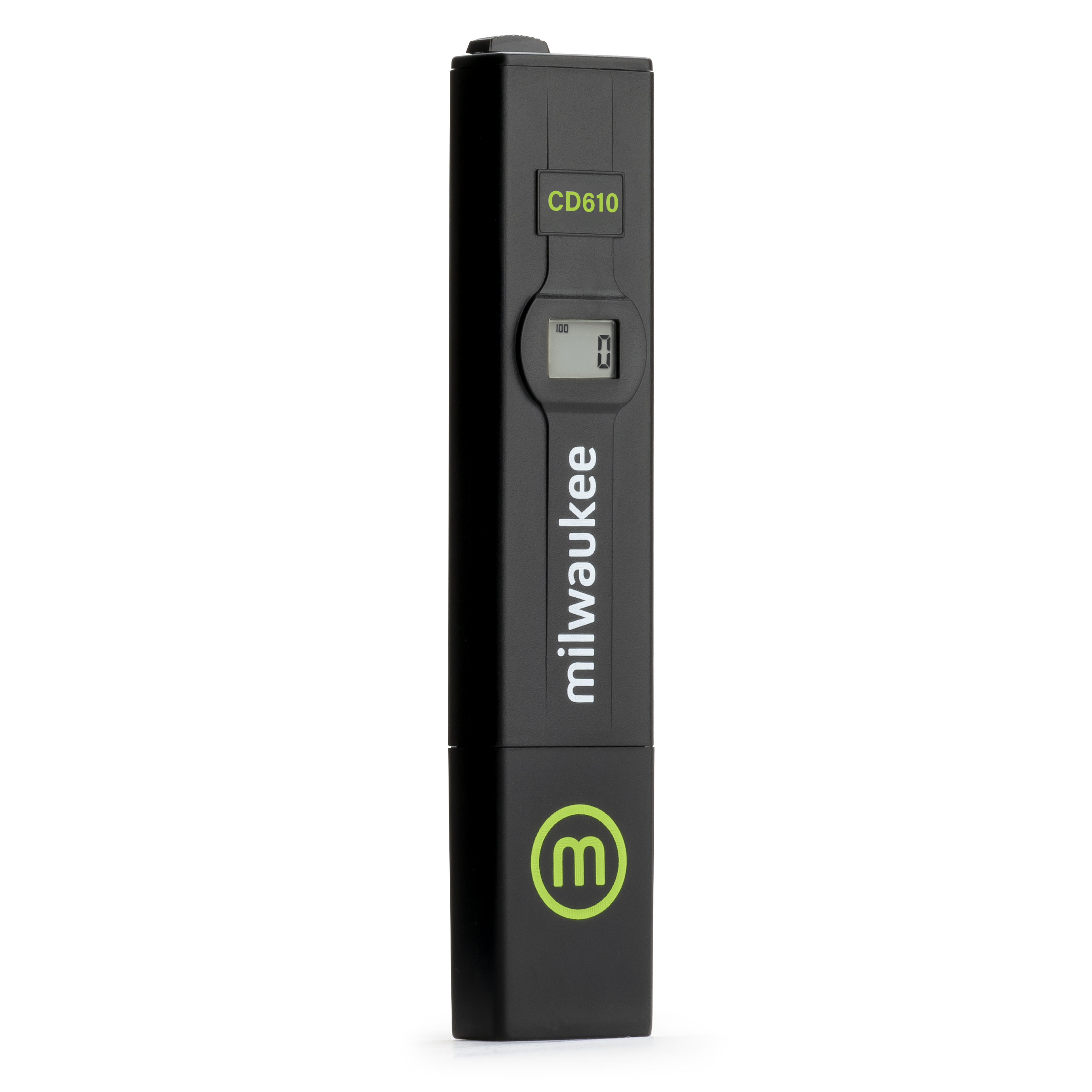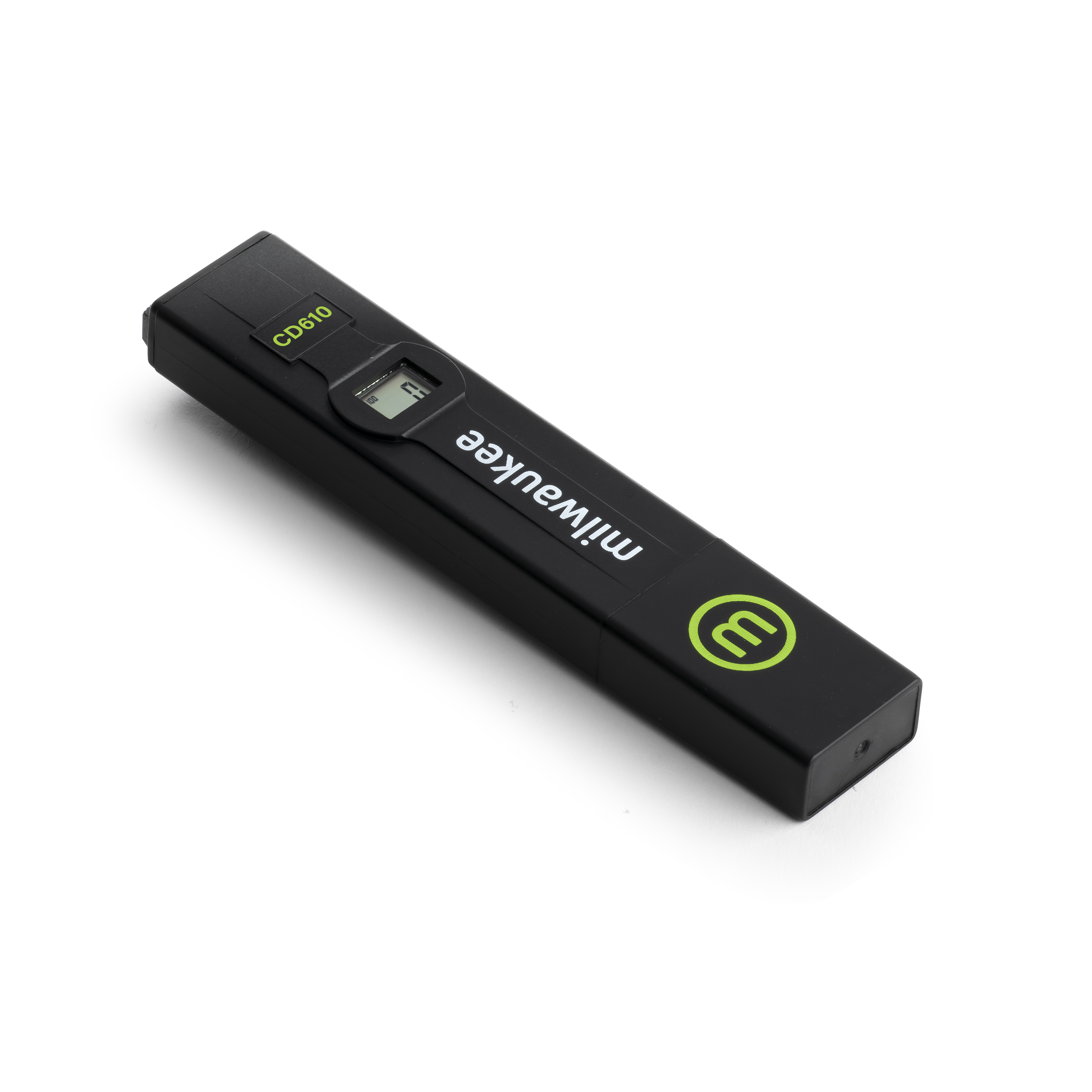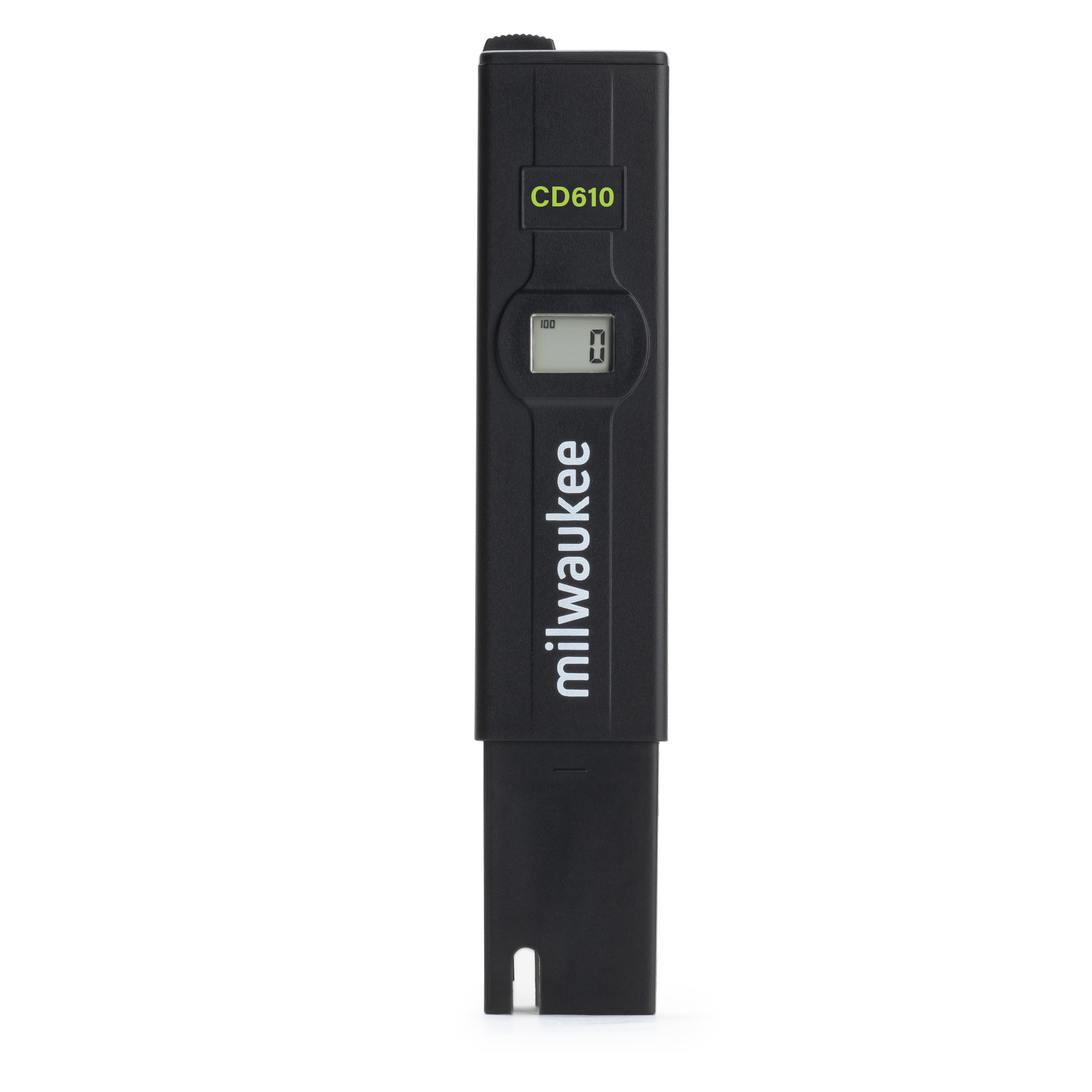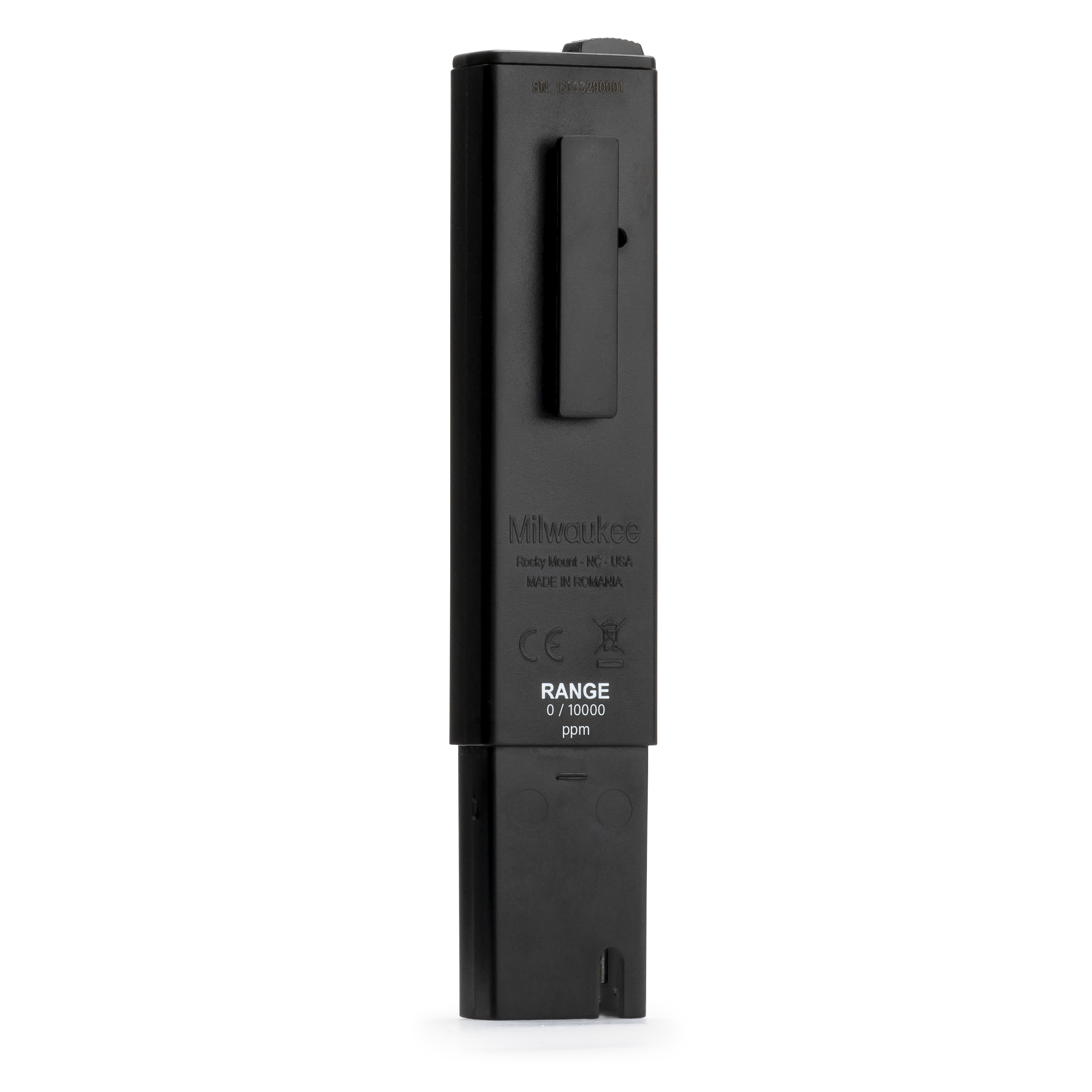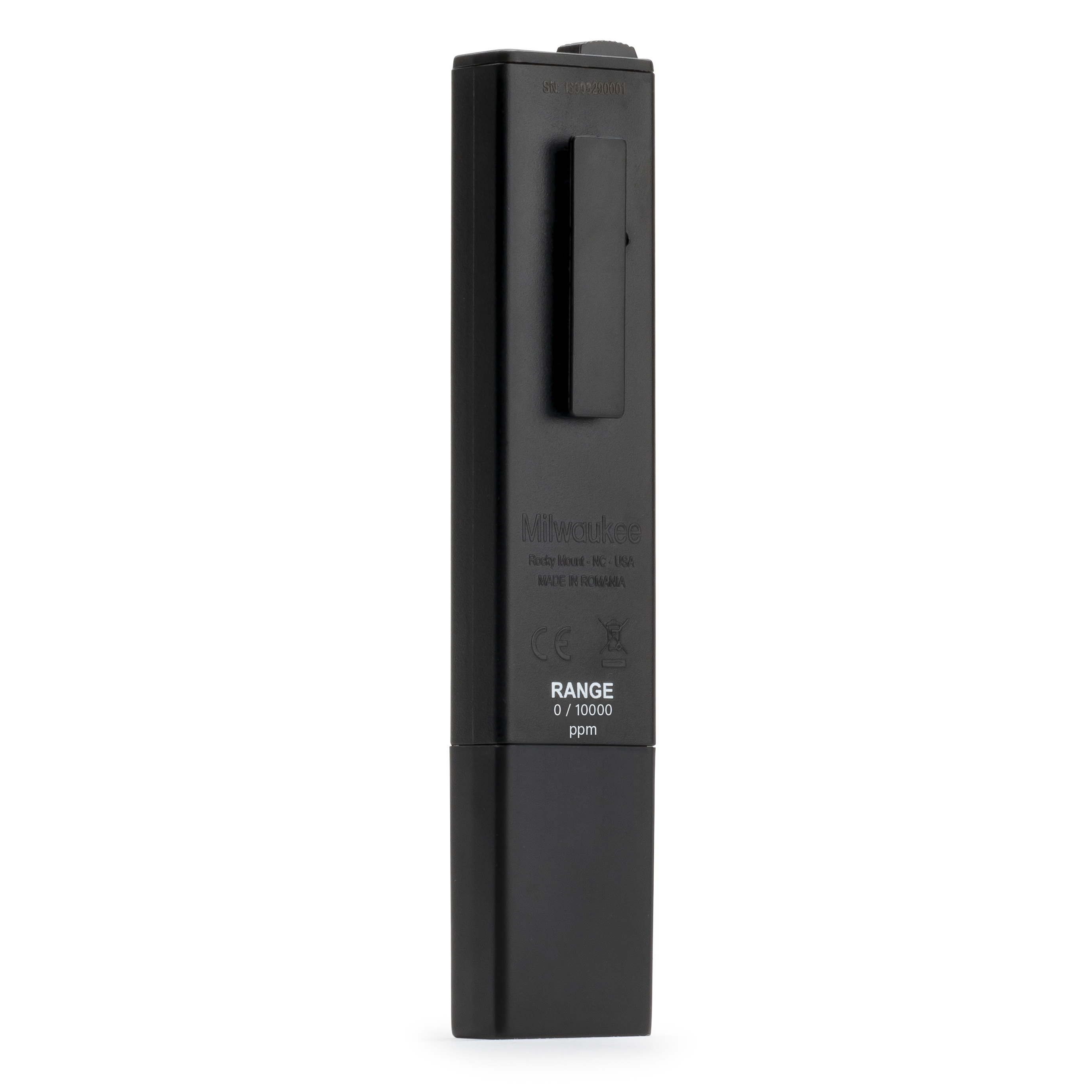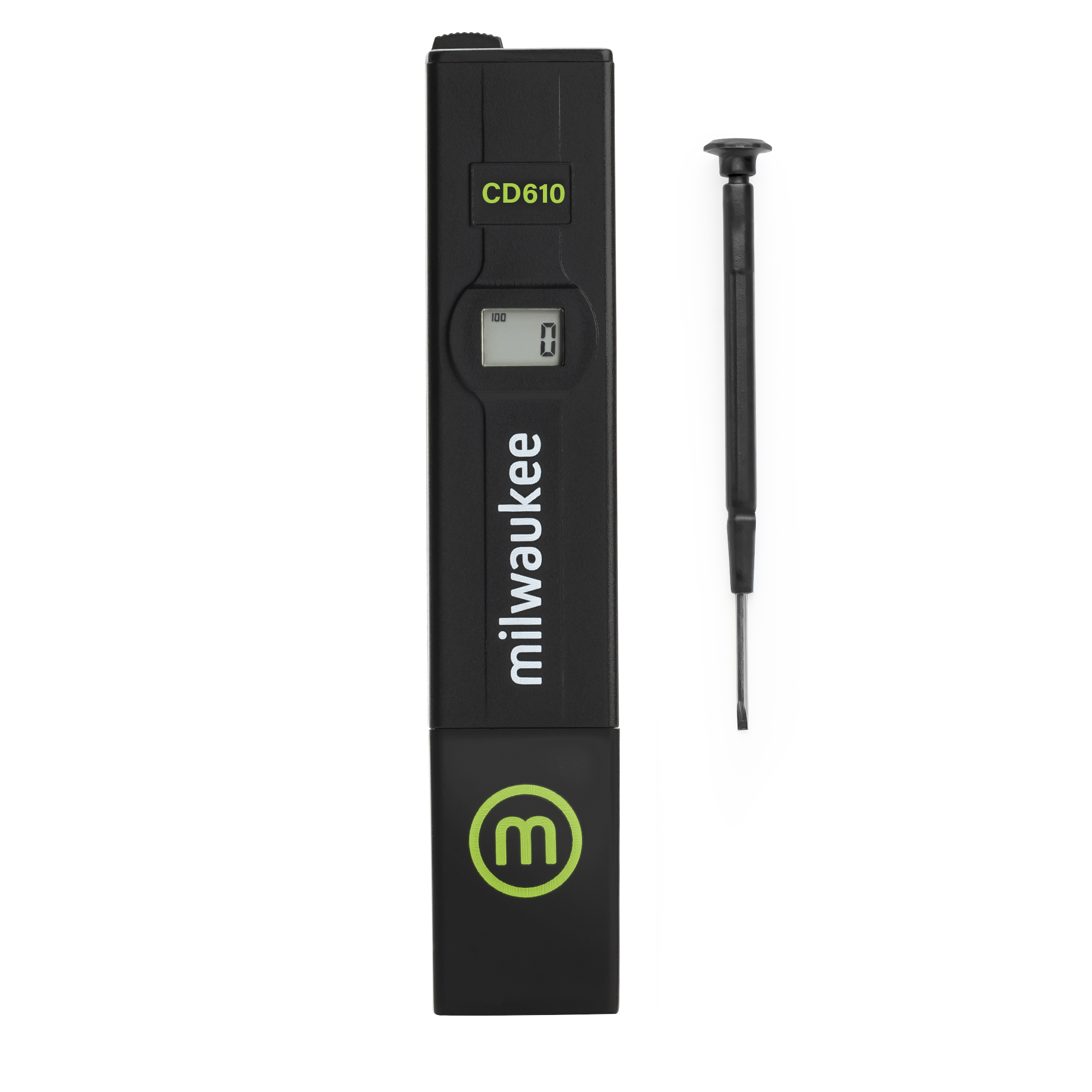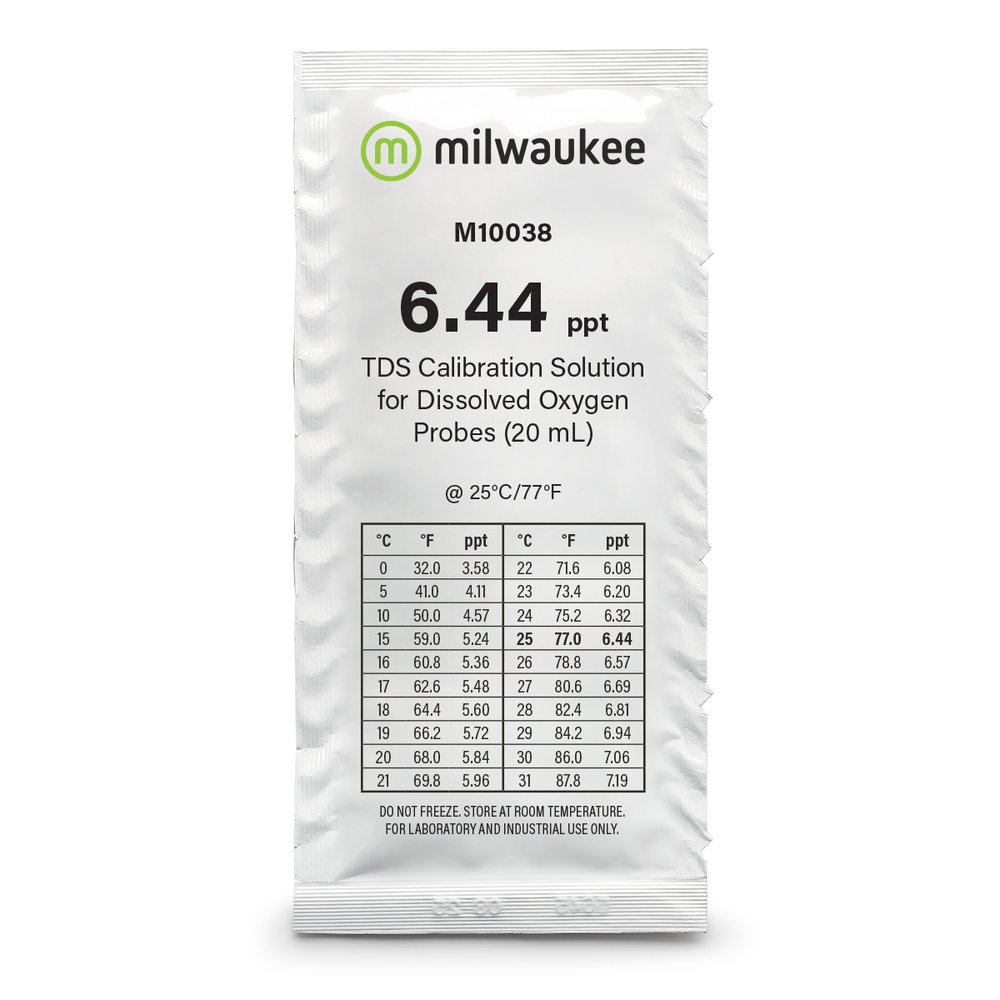Your shopping cart is currently empty.
Milwaukee CD610 Digital High Range TDS Pen – Fast & Accurate TDS Testing for Water Quality Management
Whether you're managing a hydroponic system, monitoring a koi pond, ensuring the purity of drinking water, or maintaining the perfect environment for aquaculture, measuring total dissolved solids (TDS) is a fundamental part of water quality control. The Milwaukee CD610 Digital High Range TDS Pen is designed for professionals and hobbyists alike who need quick, accurate, and reliable readings of dissolved solids in water. With a simple, portable design and a broad measurement range up to 10,000 ppm (mg/L), the CD610 makes it easy to monitor water quality with confidence – wherever you need it.
From hydroponic growers optimizing nutrient concentration to aquarium enthusiasts maintaining a stable aquatic environment, the CD610 is trusted for its speed, accuracy, and ease of use. Thanks to its automatic temperature compensation (ATC), single-point manual calibration, and replaceable probe, it delivers professional-grade performance in a convenient handheld format.
Whether it's in the field, in a lab, or at home, the CD610 provides dependable results in just seconds. Say goodbye to guesswork and ensure the quality of your water with Milwaukee's proven TDS technology.
Why Choose the Milwaukee CD610?
· High-Range Measurement (0-10,000 ppm): Perfect for a wide variety of water testing scenarios, from nutrient solutions to saltwater applications.
· Fast, Accurate Results: Factory-calibrated with ±2% full-scale accuracy and rapid response for reliable, on-the-spot TDS readings.
· Automatic Temperature Compensation (ATC): Delivers accurate results even when temperatures vary, from 5°C to 50°C.
· Replaceable Probe Design: Extends the life of the device and reduces maintenance costs.
· Compact, Portable & Durable: Ideal for fieldwork, laboratories, and on-the-go testing with over 300 hours of battery life.
· User-Friendly Operation: Simple calibration, easy-to-read LCD display, and lightweight design make this pen a convenient daily tool.
· Trusted Milwaukee Accuracy: Over 20 years of expertise in water testing ensures you get dependable, professional results.
Applications
The Milwaukee CD610 TDS Pen is versatile and essential across multiple industries and activities where monitoring dissolved solids is critical:
Hydroponics & Horticulture
- Monitor nutrient solutions to optimize plant growth.
- Ensure precise control over feeding schedules.
Aquariums & Aquaculture
- Maintain safe and stable water environments for fish and coral.
- Monitor salinity in reef tanks and mineral content in freshwater systems.
Swimming Pools & Ponds
- Quickly check TDS levels to maintain clean, balanced water.
- Ideal for koi ponds and other aquatic habitats.
Water Treatment & Conditioning
- Assess performance of reverse osmosis (RO) and deionization (DI) systems.
- Monitor water quality in treatment and purification processes.
Food & Beverage Industry
- Monitor water used in production to ensure consistency and quality.
- Applications in brewing, winemaking, and food processing.
Environmental Monitoring & Laboratories
- Test rivers, streams, and wells for contamination or mineral content.
- Suitable for fieldwork and scientific research needing fast, portable TDS checks.
Household Use
- Test tap, bottled, or filtered water quality at home.
- Identify changes in water supply conditions easily.
Proper Care & Maintenance
Storage
Your CD610 TDS Pen should be stored in a clean, dry environment when not in use. Although TDS probes are more resilient than pH electrodes, proper care will extend their lifespan. Always rinse the probe with clean water after each use to prevent salt build-up or contamination.
Cleaning
After exposure to solutions high in organic content, oils, or salts, rinse the probe thoroughly. For stubborn residues, use a mild cleaning solution designed for TDS probes.
Calibration
The CD610 features simple manual calibration. Regular calibration with standard TDS calibration solutions is recommended, especially after cleaning, prolonged storage, or frequent use in high-TDS environments. This ensures your readings remain accurate and reliable.
Achieve confidence in your water quality with the Milwaukee CD610 – the trusted choice for fast, reliable TDS testing.
Specifications
Application
Aquariums & Aquaculture
Whether you are a home aquarium hobbyist or a professional fish farmer, maintaining stable water quality is critical for the health of aquatic life. Total Dissolved Solids (TDS) are a key indicator of water purity, measuring the concentration of dissolved salts, minerals, and organic matter. Elevated or unstable TDS levels can cause stress, disease, or even death among fish, corals, and other aquatic organisms.
Freshwater Aquariums
In freshwater aquariums, excessive dissolved solids can lead to poor water clarity, algae blooms, and compromised fish health. Monitoring TDS regularly helps you understand when it's time for water changes, filtration maintenance, or adjustments in feeding and supplementation routines. Stable TDS ensures that fish, plants, and invertebrates live in an environment close to their natural habitat.
Marine & Reef Tanks
For saltwater and reef aquariums, TDS readings help track the precise salt concentrations essential for corals and marine life. Marine ecosystems are highly sensitive to fluctuations in water chemistry. Regular TDS testing ensures your synthetic seawater maintains the correct salinity and mineral balance, supporting coral calcification, vibrant coloration, and overall aquatic health.
Aquaculture (Fish Farms & Hatcheries)
In commercial aquaculture, water quality management directly impacts animal growth rates, feed conversion efficiency, and disease resistance. TDS meters like the Milwaukee CD610 enable farmers to detect contamination, monitor mineral buildup, and verify the effectiveness of water treatments, ultimately optimizing production and reducing losses.
Key Benefits of TDS Monitoring in Aquariums & Aquaculture
· Prevents harmful spikes in minerals and salts
· Helps maintain clear, healthy water for fish and corals
· Assures consistency when preparing new water batches
· Supports optimal breeding and growth conditions
· Reduces stress and disease risk through stable environments
How to Use the Milwaukee CD610 in Aquariums & Aquaculture
Using the CD610 TDS Pen is quick and straightforward. Here’s a step-by-step guide to ensure accurate results:
Step-by-Step Instructions:
Prepare the Meter
- Remove the protective cap from the probe.
- Ensure the meter is clean and has been recently calibrated with a known TDS solution.
Collect the Sample
- For aquariums: take a small sample of aquarium water in a clean container.
- For ponds or large tanks: you can immerse the probe directly into the water body.
Take the Measurement
- Turn on the CD610 meter.
- Submerge the probe tip into the water sample (make sure it is fully immersed but not touching the sides or bottom of the container).
- Wait a few seconds for the reading to stabilize.
Read the Display
- The LCD screen will show the TDS value in parts per million (ppm).
- Note this value for tracking purposes or comparison with previous readings.
Interpret the Results
- Compare the reading to the recommended TDS ranges for your specific type of aquarium or aquaculture system.
- If necessary, perform water changes, adjust filtration, or modify salt/nutrient dosing accordingly.
After Use
- Rinse the probe with distilled water to prevent buildup.
- Dry gently and replace the protective cap.
Pro Tips for Accurate TDS Measurement
- Always calibrate your CD610 regularly with fresh calibration solutions.
- Avoid touching the probe with your fingers, as oils can affect readings.
- Store the device properly with a clean, dry probe when not in use.
- Use the same container or testing method each time for consistency in your readings.
Swimming Pools
Maintaining Safe and Comfortable Water with TDS Monitoring
For swimming pools, maintaining balanced water chemistry is crucial not just for hygiene and safety, but also for user comfort and the longevity of the pool infrastructure. While pH, chlorine, and alkalinity are standard measurements in pool care, Total Dissolved Solids (TDS) often receives less attention despite being equally important.
TDS represents the total concentration of dissolved substances – salts, minerals, metals, and organic matter – present in pool water. Over time, TDS naturally increases through the addition of chemicals, environmental contaminants (like dust, sweat, and debris), evaporation, and water top-offs. Elevated TDS can lead to water quality issues, including:
- Cloudiness
- Scaling on pool surfaces and equipment
- Reduced effectiveness of sanitizing chemicals (like chlorine)
- Skin and eye irritation for swimmers
- Corrosion of pool components
Monitoring TDS helps pool owners and maintenance professionals make informed decisions about water replacement, chemical adjustments, and overall pool care. It ensures that the pool water remains clean, clear, safe, and enjoyable for swimmers.
Applications & Benefits in Swimming Pools
- Quickly checks whether TDS levels are within recommended ranges.
- Assists in determining when partial water replacement is necessary.
- Prevents long-term damage to pool equipment from high mineral buildup.
- Ensures optimal performance of sanitizers and reduces the risk of water-related complaints.
- Maintains aesthetic clarity and swimmer comfort.
Key Benefits of TDS Monitoring for Swimming Pools
· Prevents water quality issues like cloudiness and scaling
· Enhances the effectiveness of chlorine and other chemical treatments
· Protects pool infrastructure from mineral buildup and corrosion
· Helps maintain crystal-clear, inviting water
· Reduces skin and eye irritation risks for swimmers
How to Use the Milwaukee CD610 for Swimming Pools
Using the Milwaukee CD610 to monitor TDS in swimming pools is simple and efficient. Below is a step-by-step guide to ensure accurate and consistent readings.
Prepare the Meter
- Remove the protective cap from the probe.
- Confirm that the meter is clean and has been recently calibrated with a TDS calibration solution.
Collect the Sample
- Use a clean container to collect pool water from a central, calm area of the pool (mid-depth, away from inlets, outlets, and surface debris).
- Alternatively, immerse the probe directly into the pool at this location.
Take the Measurement
- Turn on the CD610 meter.
- Submerge the probe tip fully in the water, ensuring it does not touch the container’s sides or bottom if using a sample cup.
- Wait a few seconds for the reading to stabilize.
Read the Display
- The LCD screen will show the TDS level in parts per million (ppm).
- Record the reading and compare it to recommended TDS ranges for pools.
Recommended TDS Ranges for Swimming Pools:
- Freshwater pools (non-saltwater): 1,000 – 2,000 ppm is typically acceptable.
- Saltwater pools: TDS will be higher due to the added salt for chlorination, often ranging from 3,000 – 6,000 ppm depending on the system.
If TDS readings exceed recommended limits:
- Plan for partial water replacement to dilute accumulated solids.
- Reassess maintenance routines and chemical use to prevent rapid buildup.
After Use
- Rinse the probe with clean, distilled water after testing to avoid residue buildup.
- Dry gently and replace the protective cap.
- Store the meter in a dry, clean location.
Pro Tips for Best Accuracy
- Calibrate regularly with fresh calibration solutions for TDS.
- Take readings at consistent times (e.g., after filtration cycles) for reliable trend analysis.
- Avoid testing near returns, skimmers, or turbulence.
- Clean the probe periodically to maintain sensitivity and accuracy.
Hydroponics & Horticulture
Precision Nutrient Management with TDS Monitoring
In hydroponic systems and horticulture, plants receive their nutrients directly through water-based solutions rather than soil. This makes precise control of nutrient concentrations absolutely critical to plant health, growth, and yield. One of the simplest and most effective ways to monitor nutrient strength is through Total Dissolved Solids (TDS) measurement.
TDS reflects the total concentration of dissolved salts and minerals (nutrients) in your solution, expressed in parts per million (ppm). By regularly monitoring TDS, growers can ensure their nutrient solutions remain within the optimal range for the specific crops they are cultivating. Incorrect TDS levels can cause a range of problems:
- Too high: Nutrient toxicity, root burn, stunted growth.
- Too low: Nutrient deficiencies, weak plants, poor yields.
Consistent TDS monitoring with a tool like the Milwaukee CD610 allows for precise adjustments, helping plants thrive and supporting predictable, high-quality harvests.
Applications & Benefits in Hydroponics & Horticulture
- Tracks nutrient concentrations to optimize feeding schedules.
- Prevents overfeeding or underfeeding, both of which can harm plants.
- Provides quick, easy checks on solution strength during preparation and maintenance.
- Helps maintain consistency across growth cycles for better yield predictability.
- Supports hydroponic systems, soil-less agriculture, fertigation systems, and greenhouse horticulture.
Key Benefits of TDS Monitoring for Hydroponics & Horticulture
· Ensures optimal nutrient concentration for vigorous growth
· Prevents costly crop damage from nutrient imbalances
· Simplifies adjustments to feeding regimes based on plant stage
· Provides immediate feedback for solution preparation
· Supports consistency and quality in commercial growing operations
How to Use the Milwaukee CD610 for Hydroponics & Horticulture
Using the Milwaukee CD610 to monitor TDS in hydroponic nutrient solutions is straightforward and helps ensure optimal growing conditions. Below is a step-by-step guide for best practices.
Prepare the Meter
- Remove the protective cap from the probe.
- Confirm the meter is clean and properly calibrated with a TDS calibration solution.
Collect the Sample
- Collect a sample of your nutrient solution in a clean container, ensuring the sample is well-mixed and representative.
- Alternatively, immerse the probe directly into the nutrient reservoir, avoiding areas near pumps or turbulence.
Take the Measurement
- Turn on the CD610 meter.
- Submerge the probe tip fully into the solution.
- Wait a few seconds for the reading to stabilize.
Read the Display
- The LCD screen will show the TDS level in parts per million (ppm).
- Compare the reading to the recommended ranges for your specific crop and growth stage.
Interpret the Results & Adjust
- If TDS is too low: add more nutrients carefully and retest.
- If TDS is too high: dilute the solution with fresh water and retest.
Maintaining stable, targeted TDS levels ensures plants receive the right nutrients at the right time.
After Use
- Rinse the probe with clean, distilled water to remove residue.
- Dry gently and replace the protective cap.
- Store the device properly in a dry, clean place.
Pro Tips for Best Accuracy
-
Regularly calibrate the CD610 with fresh calibration solutions for precise readings.
-
Monitor TDS at the same time daily to track trends consistently.
-
Clean the probe routinely, especially after contact with concentrated nutrient solutions.
-
Use TDS readings in conjunction with pH monitoring for a complete picture of solution health.
Education & Laboratories
A Practical Tool for Teaching Water Chemistry Fundamentals
In educational environments, science classrooms, and teaching laboratories, hands-on experiments are a cornerstone of learning. The Milwaukee CD610 TDS Pen offers a simple, reliable, and cost-effective method for students to explore essential scientific principles related to water chemistry, such as solubility, conductivity, and total dissolved solids (TDS).
TDS measurement provides a direct, practical link between theoretical knowledge and real-world observation. By measuring the concentration of dissolved substances in a solution, students can grasp how salts, minerals, and other compounds influence water quality and conductivity. These principles are fundamental not only in chemistry and environmental science but also in fields like biology, agriculture, and engineering.
Because the CD610 is portable, user-friendly, and robust, it is ideal for repeated classroom use and demonstrations, making it easier for educators to integrate hands-on water testing into the curriculum.
Applications & Benefits in Education & Laboratories
- Demonstrates real-world applications of chemistry concepts like molarity, solubility, and ionic strength.
- Provides practical experience with digital instrumentation used in professional settings.
- Supports a wide range of experiments: from testing bottled vs. tap water to analyzing environmental water samples.
- Helps students understand the impact of dissolved solids on water quality, health, and ecosystems.
- Encourages critical thinking by allowing students to collect, analyze, and interpret scientific data.
Key Benefits of TDS Monitoring
· Engages students with practical, hands-on learning
· Simplifies complex chemical concepts through clear data
· Encourages inquiry-based and experiential science education
· Durable and cost-effective for frequent classroom use
· Builds familiarity with professional water quality testing tools
How to Use the Milwaukee CD610
Using the Milwaukee CD610 for educational purposes is straightforward, making it perfect for students and instructors alike. Below is a simple, step-by-step guide designed for classroom and lab environments.
Prepare the Meter
- Remove the protective cap from the probe.
- Ensure the device is clean and has been recently calibrated with a TDS calibration solution.
Prepare the Sample
- Collect the water sample to be tested in a clean beaker or container. This could be:
- Tap water
- Bottled water
- Prepared saltwater solutions for experiments
- Environmental water sources (ponds, rivers)
Ensure samples are free from visible debris.
Take the Measurement
- Turn on the CD610 meter.
- Submerge the probe tip fully in the sample, ensuring it doesn’t touch the container sides or bottom.
- Wait a few seconds until the reading stabilizes.
Read the Display
- The LCD screen will show the TDS value in parts per million (ppm).
- Record this value for analysis, comparison, or reporting.
Interpret the Results
- Use the readings to support lessons on:
- Water quality and pollution
- Solubility and saturation
- Conductivity vs. dissolved solids
- Chemical reactions and solution concentration
Discuss with students how these measurements reflect real-world scenarios, such as drinking water standards or environmental monitoring.
After Use
- Rinse the probe with clean, distilled water between different samples to avoid contamination.
- Gently dry and replace the protective cap.
- Store the device properly.
Pro Tips for Educational Success
- Always calibrate the CD610 before key experiments to ensure accuracy.
- Use standardized solutions for calibration to reinforce proper scientific methodology.
- Encourage students to graph TDS data across various samples to enhance analytical skills.
- Integrate discussions about how TDS relates to broader scientific or environmental issues.
Environmental Monitoring
Quick & Reliable Water Quality Assessments in the Field
For professionals and organizations involved in environmental science, field research, water resource management, and ecological protection, monitoring water quality is fundamental to understanding the health of natural ecosystems. Total Dissolved Solids (TDS) measurement provides a quick, reliable method to assess water purity, detect possible contamination, and monitor changes over time in various water bodies such as rivers, streams, lakes, reservoirs, and wells.
TDS reflects the concentration of inorganic salts (calcium, magnesium, potassium, sodium, bicarbonates, chlorides, sulfates) and small amounts of organic matter dissolved in water. These levels can naturally vary based on geological factors but may spike due to human activity like agriculture runoff, industrial discharges, or wastewater leakage. Monitoring TDS helps identify pollution, verify the success of treatment efforts, or establish baseline data for long-term studies.
The Milwaukee CD610 is particularly suited for this type of work thanks to its durability, portability, and quick, accurate readings, making it easy to assess water quality directly in the field without the need for complicated lab equipment.
Applications & Benefits in Environmental Monitoring
- Rapid on-site assessment of water quality in natural or man-made water bodies.
- Identification of potential contamination from agricultural, industrial, or urban sources.
- Monitoring groundwater quality through well testing.
- Evaluation of changes in mineral content caused by environmental shifts (e.g., drought, flooding).
- Support for water treatment verification by comparing input and output water TDS.
Key Benefits of TDS Monitoring for Environmental Monitoring
· Provides immediate, actionable data in the field
· Identifies trends and anomalies that could indicate pollution or contamination
· Simplifies long-term water quality studies through repeatable testing
· Requires no complex laboratory setup
· Durable and portable for rugged outdoor use
How to Use the Milwaukee CD610 for Environmental Monitoring
Using the Milwaukee CD610 for environmental water testing is straightforward, making it ideal for researchers, technicians, and environmental monitoring teams conducting fieldwork. Below is a step-by-step guide to ensure accurate and consistent results.
Prepare the Meter
- Remove the protective cap from the probe.
- Confirm the meter is clean and calibrated using a standard TDS calibration solution before heading into the field.
Collect the Sample
- Collect water from the source using a clean sample container, ideally from mid-depth away from the bank, sediment, or surface debris.
- For wells or easily accessible streams, the probe can be dipped directly into the water.
- Label samples clearly if collecting from multiple locations.
Take the Measurement
- Turn on the CD610 meter.
- Submerge the probe tip fully into the water or sample container, ensuring it avoids contact with sediment or container surfaces.
- Allow a few seconds for the reading to stabilize.
Read the Display
- The LCD screen will display the TDS reading in parts per million (ppm).
- Record the reading along with the location, date, and any environmental observations (e.g., temperature, weather conditions).
Interpret the Results
- Compare readings against local or international water quality standards.
- Note significant increases or fluctuations that may suggest contamination, runoff, or geological influences.
- If tracking over time, plot readings to observe trends in environmental changes.
After Use
- Rinse the probe thoroughly with distilled or deionized water to prevent contamination between sites.
- Dry gently and replace the protective cap.
- Store the meter properly in a dry, clean place for the next use.
Pro Tips for Accurate Field Measurements
- Always calibrate the meter before major fieldwork campaigns to ensure accuracy.
- Avoid measuring in stagnant water where sediment or organic matter may skew results.
- Take multiple readings across various locations within a body of water for a more comprehensive assessment.
- Document conditions thoroughly to contextualize TDS readings (e.g., rainfall, agricultural activity nearby).
Beverage & Food Industry
Quality Control for Taste, Consistency & Process Optimization
In the beverage and food industries, water is not just an ingredient – it’s a fundamental part of production. Whether it’s used in brewing beer, crafting wine, formulating beverages, or processing food, the quality of water directly influences the taste, texture, appearance, and overall quality of the final product. Total Dissolved Solids (TDS) measurement provides a fast and reliable indicator of water purity and mineral content, which in turn impacts everything from fermentation processes to product consistency.
TDS reflects the combined content of all inorganic salts and some organic matter present in water, such as calcium, magnesium, sodium, bicarbonates, chlorides, and sulfates. These elements can significantly influence flavor profiles, mouthfeel, brewing efficiency, and consistency across production batches.
By incorporating TDS monitoring with tools like the Milwaukee CD610, producers gain a simple, effective method for performing preliminary checks on water or liquid solutions to verify suitability for production processes or to maintain quality standards throughout the workflow.
Applications & Benefits in the Beverage & Food Industry
- Verifying water quality consistency for use in brewing, distillation, and food preparation.
- Ensuring suitable mineral content to support optimal fermentation in beer and wine production.
- Monitoring TDS in cleaning and rinsing processes to prevent contamination.
- Supporting product consistency by checking dissolved solids in syrups, concentrates, and other liquid bases.
- Identifying potential contamination or filtration issues early in the process.
Key Benefits of TDS Monitoring for the Food & Beverage Industry
· Supports consistent product taste and texture
· Verifies water quality for critical production stages
· Helps optimize brewing and fermentation conditions
· Prevents unexpected variations between batches
· Easy-to-use tool for routine spot checks and QA procedures
How to Use the Milwaukee CD610 for the Beverage & Food Industry
Using the Milwaukee CD610 for routine checks in beverage and food production is fast, efficient, and user-friendly. Below is a clear, step-by-step guide to ensure accurate readings.
Prepare the Meter
- Remove the protective cap from the probe.
- Ensure the device is clean and recently calibrated with a TDS calibration solution for accurate measurement.
Prepare the Sample
- Collect water, brine, syrup, or beverage solution to be tested in a clean, food-grade container.
- Ensure the sample is well-mixed and free of air bubbles for consistency.
Take the Measurement
- Turn on the CD610 meter.
- Submerge the probe tip fully in the liquid sample, avoiding contact with the container sides or bottom.
- Allow a few seconds for the reading to stabilize.
Read the Display
- The LCD screen will display the TDS measurement in parts per million (ppm).
- Record the reading for quality control records or comparison against specifications.
Interpret the Results
- Compare readings to internal quality standards or industry benchmarks.
- For water used in brewing, coffee, or food prep, target TDS levels often fall between 50-500 ppm, depending on the process and desired product characteristics.
- High TDS in water can impact flavor, while inconsistencies in other liquid components can affect product consistency and stability.
If readings are outside the expected range:
- Review filtration systems, water sources, or ingredient formulations.
- Take corrective action as necessary to maintain product quality.
After Use
- Rinse the probe thoroughly with distilled or deionized water between different samples.
- Gently dry and replace the protective cap.
- Store the meter properly in a clean, dry location.
Pro Tips for Accurate Measurements
- Calibrate the CD610 regularly with fresh calibration standards, especially for sensitive applications like brewing or winemaking.
- Conduct tests at the same temperature range where possible to reduce variation (temperature compensation is built-in but consistency helps).
- Use clean, standardized containers to prevent cross-contamination between tests.
- Incorporate TDS readings into your broader HACCP or QA protocols for better traceability.




